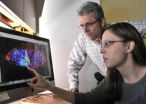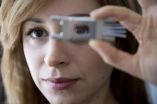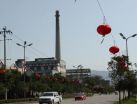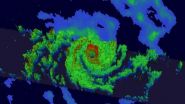(Press-News.org) Patients with leukocyte adhesion deficiency, or LAD, suffer from frequent bacterial infections, including the severe gum disease known as periodontitis. These patients often lose their teeth early in life.
New research by University of Pennsylvania School of Dental Medicine researchers, teaming with investigators from the National Institutes of Health, has demonstrated a method of reversing this bone loss and inflammation.
The work was led by Penn Dental Medicine's George Hajishengallis, professor in the Department of Microbiology, in collaboration with Niki Moutsopoulos of the National Institute of Dental and Craniofacial Research. It was published in the journal Science Translational Medicine.
Leukocyte adhesion deficiency is a rare but life-threatening disease. Patients can succumb to bacterial infections because their immune systems lack a molecule required by immune cells, specifically neutrophils, to go to the site of infection.
Researchers used to believe that LAD patients developed severe periodontitis because of this inability of neutrophils to cross from the bloodstream into gum tissue. Bacteria, therefore, were believed to thrive unchecked in the gums.
"Because this view was so reasonable, nobody had questioned it," Hajishengallis said.
The new study challenges this assumption.
The team led by Hajishengallis and Moutsopoulos noticed that gum disease and bone loss continued unchecked even when LAD patients were given antibiotics or had their plaque removed. As expected, the LAD patients did not have neutrophils in their gum tissue, only in the bloodstream. Looking more closely, however, they realized that these patients had abundant bacteria on the surface of their teeth but normal bacterial levels inside their gums.
"This is a very different form of periodontitis than we see in otherwise healthy people, in which the neutrophils can cause disease by being too active or present at high numbers in the gums," Hajishengallis said.
To understand what was unique about the LAD patients' disease, the researchers examined their immune system-related genes and proteins. Compared to people with periodontitis or gingivitis who were otherwise healthy, one molecule in particular stood out: people with LAD had very high levels of IL-17 mRNA and IL-17-expressing cells in their gum tissue.
These findings matched up with what the researchers had observed in mice that were bred to lack LFA-1, a molecule that normally helps neutrophils exit the bloodstream. Like human LAD patients, these mice had serious periodontal disease early in life, and their gums contained high levels of IL-17 mRNA and protein, as well as IL-23, a protein in the same pathway as IL-17.
IL-17 is in a signaling pathway that acts as a feedback loop for the immune system. When the pathway senses that a tissue contains few neutrophils, levels of IL-23 and IL-17 go up, encouraging more neutrophil production and migration from the bloodstream into the tissue. But, because LAD patients' neutrophils cannot move into the tissue, this pathway goes awry, leading to inflammation.
Not only can IL-17 encourage inflammation, but it can also encourage the development of osteoclasts, cells that break down bone, in this case teeth.
"We suspected that the bone loss was occurring because of IL-17 and not because the neutrophils could not control the bacterial infection," Hajishengallis said.
To determine whether IL-17 or IL-23 was to blame for the periodontitis and bone loss in the mice with the LAD-like disease, the researchers injected molecules that block these proteins' activity in their gums.
"We found out that by blocking these two, not only do we inhibit inflammation and bone loss, but we also inhibit the bacterial overgrowth," Hajishengallis said. "This is not as strange as it might sound. Periodontal bacteria thrive on inflammation. Consuming the breakdown products of tissues is how they get their food. So if you inhibit inflammation you starve them."
The authors said that this result suggests that the reason bacterial numbers are so high in these mice, and, by extension, human LAD patients, is not because of a defect in the immune system's surveillance mechanism but because of the inflammation caused by the immune system's abnormal response to normal levels of bacteria in the gums.
"So in other words the bacterial overgrowth is the result and not the cause of this type of periodontitis," Hajishengallis said.
Molecules that target and inhibit the activity of IL-17 are already used to treat autoimmune diseases such as psoriasis and rheumatoid arthritis, so the researchers want to see whether these compounds could also be used to treat periodontitis in LAD patients.
INFORMATION:
Additional authors on the study included Penn Dental Medicine's Camille Zenobia, Kavita B. Hosur and Toshiharu Abe; the National Institute of Dental and Craniofacial Research's Joanne Konkel, Mojgan Sarmadi, Teresa Wild, Nicolas Dutzan, Loreto Abusleme and WanJun Chen; the University of Louisville School of Dentistry's Mehmet A. Eskan; the National Institute of Allergy and Infectious Diseases' Steven M. Holland and Gulbu Uzel; and Technische Universität Dresden's Triantafyllos Chavakis.
The work was supported by the National Institutes of Health — specifically the National Institute of Dental and Craniofacial Research and the National Institute of Allergy and Infectious Disease — the Deutsche Forschungsgemeinschaft, the European Research Council and the U.S. Public Health Service.
Penn Dental Medicine-NIH team reverses bone loss in immune disorder
2014-03-26
ELSE PRESS RELEASES FROM THIS DATE:
Researchers present comprehensive 'roadmap' of blood cells
2014-03-26
(WASHINGTON, March 26, 2014) – Research published online today in Blood, the Journal of the American Society of Hematology, presents an unprecedented look at five unique blood cells in the human body, pinpointing the location of key genetic regulators in these cells and providing a new tool that may help scientists to identify how blood cells form and shed light on the etiology of blood diseases.
Work published today in Blood* is a subset of a much larger catalog of genetic information about nearly 1,000 human cells and tissues unveiled today from the international research ...
3-D MRI scans may offer better way to predict survival after chemo for liver tumors
2014-03-26
In a series of studies involving 140 American men and women with liver tumors, researchers at Johns Hopkins have used specialized 3-D MRI scans to precisely measure living and dying tumor tissue to quickly show whether highly toxic chemotherapy – delivered directly through a tumor's blood supply – is working.
The investigators say their findings, to be presented March 22-27 in San Diego at the annual meeting of the Society of Interventional Radiology, are the first "proof of principle" that this technology can show tumors in three dimensions and accurately measure tumor ...
Lawrence Livermore scientists discover bacterial resistance to improve biofuel production
2014-03-26
Resistance is not futile when it comes to a new method to more efficiently convert biomass to biofuels.
New research by scientists from Lawrence Livermore National Laboratory in conjunction with the Joint BioEnergy Institute (JBEI) suggests that a type of bacterial resistance may provide more efficient production of biofuels.
The team identified the genetic origin of bacterial resistance to an ionic liquid (a salt in the liquid state), which they successfully introduced into a strain of E. coli bacteria for the production of advanced biofuels. The ionic liquid resistance ...
Significant progress toward creating 'benchtop human' reported
2014-03-26
Significant progress toward creating "homo minutus" - a benchtop human -was reported at the Society of Toxicology meeting on Mar. 26 in Phoenix.
The advance - successful development and analysis of a liver human organ construct that responds to exposure to a toxic chemical much like a real liver- was described in a presentation by John Wikswo, the Gordon A. Cain University Professor and Director of the Vanderbilt Institute for Integrative Biosystems Research and Education (VIIBRE) at Vanderbilt University.
The achievement is the first result from a five-year, $19 million ...
UT Southwestern cancer biologists link tumor suppressor gene to stem cells
2014-03-26
DALLAS – March 26, 2014 – Just as archeologists try to decipher ancient tablets to discern their meaning, UT Southwestern Medical Center cancer biologists are working to decode the purpose of an ancient gene considered one of the most important in cancer research.
The p53 gene appears to be involved in signaling other cells instrumental in stopping tumor development. But the p53 gene predates cancer, so scientists are uncertain what its original function is.
In trying to unravel the mystery, Dr. John Abrams, Professor of Cell Biology at UT Southwestern, and his team ...
Biological testing tool, ScanDrop, tests in fraction of time and cost of industry standard
2014-03-26
Northeastern University professor of pharmaceutical sciences, Tania Konry, has developed a single instrument that can conduct a wide range of biological scans in a fraction of the time and cost of industry standard equipment. That's because it uses considerably less material and ultra-sensitive detection methods to do the same thing.
Currently, researchers face enormous time constraints and financial hurdles from having to run these analyses on a regular basis. Hundreds of dollars and 24 hours are what's required to scan biological materials for important biomarkers that ...
Natural history must reclaim its place
2014-03-26
Support in developed countries for natural history—the study of the fundamental nature of organisms and how and where they live and interact with their environment—appears to be in steep decline. Yet natural history provides essential knowledge for fields as varied as human health, food security, conservation, land management, and recreation. In the April issue of BioScience, a group of scientists from institutions across North America details examples supporting their conviction that a revitalization of the practice of natural history will provide important benefits for ...
Coal plant closure in China led to improvements in children's health
2014-03-26
Decreased exposure to air pollution in utero is linked with improved childhood developmental scores and higher levels of brain-derived neurotrophic factor (BDNF), a key protein for brain development, according to a study looking at the closure of a coal-burning power plant in China led by researchers at the Columbia Center for Children's Environmental Health at the Mailman School of Public Health.
The study is the first to assess BDNF and cognitive development with respect to prenatal exposure to polycyclic aromatic hydrocarbons (PAH), a component of air pollution commonly ...
Resistance is not futile
2014-03-26
Researchers with the U.S. Department of Energy (DOE)'s Joint BioEnergy Institute (JBEI), a multi-institutional partnership led by Berkeley Lab, have identified the genetic origins of a microbial resistance to ionic liquids and successfully introduced this resistance into a strain of E. coli bacteria for the production of advanced biofuels. The ionic liquid resistance is based on a pair of genes discovered in a bacterium native to a tropical rainforest in Puerto Rico.
"We identified two genes in Enterobacter lignolyticus, a soil bacterium that is tolerant to imidazolium-based ...
NASA catches Gillian as a super-cyclone before quickly dissipating
2014-03-26
VIDEO:
On March 23 when the TRMM satellite passed over Gillian, it was at hurricane-force. TRMM revealed intense storms in a well-defined eye wall producing rain at a rate of over...
Click here for more information.
Tropical Cyclone Gillian was near peak intensity when the Tropical Rainfall Measuring Mission or TRMM satellite passed overhead and saw towering thunderstorms and very heavy rainfall in the storm on March 23. By March 26, Gillian had weakened to a tropical storm and ...





